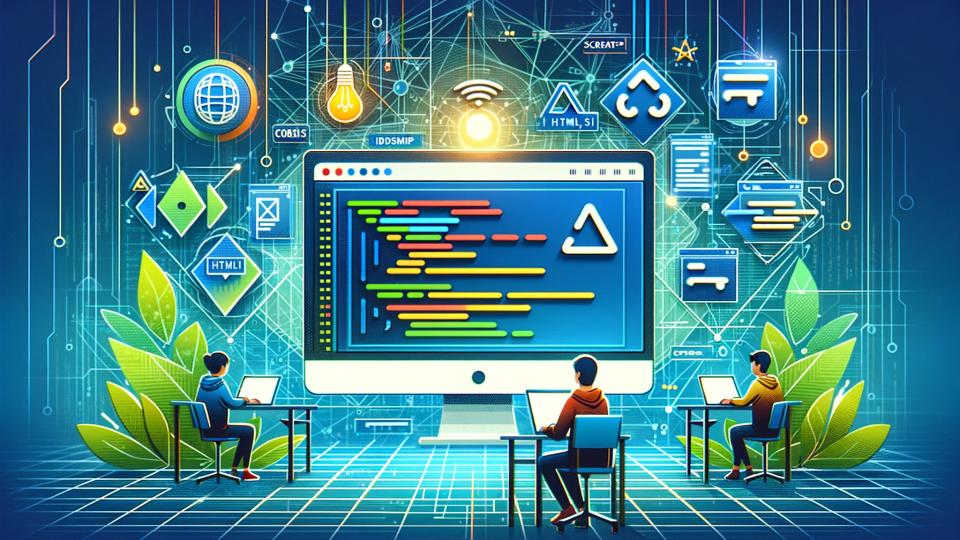Programming, often referred to as coding, is the process of creating instructions that tell computers how to perform tasks. It’s akin to writing a recipe for a computer to follow. Just like a recipe can instruct you to bake a cake, a program instructs a computer to perform tasks like calculating numbers, storing information, or displaying data.
At its core, programming is about problem-solving. Programmers use their understanding of computers and coding languages to create efficient and effective solutions to problems. This skill is increasingly valuable in a world where technology plays a central role in almost every aspect of daily life.
Why Programming Matters Today
In today’s technology-driven world, programming has emerged as a fundamental skill for various reasons. Firstly, it’s the foundation of the digital world, essential for everything from smartphone apps to websites. It’s not just limited to technology companies; programming skills are in demand across diverse industries. Moreover, coding enhances problem-solving and critical thinking, applicable in many life scenarios. The versatility of programming means it’s useful in numerous fields, from finance to healthcare. Learning to program opens up a multitude of career opportunities, enabling innovation and the ability to bring creative ideas to life. It’s a skill that equips you to create, innovate, and efficiently solve problems, making it an essential part of modern literacy.
The World of Programming Languages
A programming language is like a set of instructions that a computer understands. Just like we have different languages like English, Spanish, or Mandarin, there are various programming languages, each with its own syntax and use cases. Some of the most popular ones include:

- Python
- JavaScript
- Java
- C++
Each language has its own strengths and is suited for different types of projects. The choice of which language to learn first depends on your interests, the specific tasks you want to accomplish, and the industry you’re interested in.
Programming, at its heart, is about giving life to ideas through code. It’s a skill that empowers you to create, innovate, and solve problems in unique and efficient ways. As we move forward in an increasingly digital world, the ability to program is becoming an essential literacy.
Whether you aspire to develop the next groundbreaking app, analyze data for impactful insights, or simply want to understand the technology around you better, learning to program is the first step on an exciting journey of discovery and creation.
Choosing the Right Programming Language
Selecting the right programming language is a crucial step in your journey to becoming a programmer. This choice often depends on your goals, interests, and the specific tasks you wish to accomplish. Below is a brief overview of some popular programming languages and factors to consider when choosing one.
Popular Programming Languages
- Python: Renowned for its simplicity, Python is an excellent choice for beginners. It’s widely used in fields like web development, data analysis, artificial intelligence, and scientific computing. Python’s readability makes it a great starting point for those new to coding.
- JavaScript: As the backbone of web development, JavaScript is essential for creating interactive and dynamic web pages. It runs in the browser, making it crucial for front-end development, and with environments like Node.js, it’s also used in server-side programming.
- Java: Known for its portability across platforms, Java is used in a variety of applications, from Android app development to large-scale enterprise systems. It’s a versatile language with strong demand in the job market.
- C++: Favored for its performance, C++ is used in software development, game development, and systems programming. It’s more complex than Python or JavaScript but offers greater control over computer resources.
Factors to Consider
When choosing a programming language, several key factors should guide your decision. Firstly, consider your personal interests and the type of projects you intend to undertake. For instance, if web development fascinates you, learning languages like JavaScript and HTML/CSS is essential. Secondly, it’s important to research the demand for different programming languages in your targeted industry. Languages like Python and JavaScript, for example, are highly sought after in many sectors. Thirdly, ease of learning is a crucial aspect, especially for beginners. Languages such as Python are recommended for their straightforward syntax, making them beginner-friendly. Lastly, the strength of the language’s community is an important consideration. A robust community can offer invaluable support and resources. Languages like Python and JavaScript boast large, active communities that can greatly aid in your learning journey. Remember, the choice of your first programming language is just the start; many programmers learn multiple languages as they progress in their careers.
The best programming language to start with depends on your personal goals, interests, and the specific type of projects you wish to work on. Each language has its strengths and ideal use cases, making it important to align your choice with your long-term objectives. Remember, the first language you learn is just the beginning of your coding journey, not the sole determinant of your future in programming.
Understanding the Basics of Programming
Once you’ve chosen a programming language, the next step is to understand the fundamental concepts of programming. These basics form the foundation upon which all programming skills are built. Grasping these concepts is crucial for developing the ability to write and understand code.
Key Programming Concepts
In programming, getting a firm grasp on the basic concepts is akin to learning the alphabet before writing full sentences. These foundational elements include variables and data types, control structures, functions and methods, basic input and output, and error handling.
Variables and data types are the core components for storing and manipulating data in a program. Think of variables as containers holding information, and data types specify the kind of data these containers can hold, be it numbers, text, or more complex types.
Control structures are the logical constructs that guide the flow of a program. They include ‘if’ statements, which allow the program to make decisions, and loops like ‘for’ and ‘while’, which enable repetitive execution of code blocks.
Functions and methods are reusable code blocks designed to perform specific tasks. They simplify complex problems by breaking them down into smaller, more manageable parts. This not only makes your code more efficient but also easier to understand and maintain.
Basic input and output operations are fundamental for creating interactive programs. They enable your program to receive information from users (input) and display information back to them (output).
Error handling is a critical aspect of programming that involves anticipating and managing potential errors during execution. Effective error handling ensures that your program can handle unexpected situations gracefully, enhancing its reliability and user experience.
Practical Exercises and Examples
To solidify your understanding of these concepts, engaging in practical exercises is crucial. For instance, you can create a program that uses variables to store different data types and then prints this information. Experiment with control structures by writing a program that uses ‘if’ statements to navigate through multiple conditions and employs loops to perform repetitive tasks.
Developing a function for a simple calculation and using it with varied inputs is a great way to understand the power of reusable code. A basic calculator that takes user inputs to perform arithmetic operations can be a practical project for mastering basic input and output.
Incorporating error handling in your programs, such as adding checks in your calculator to prevent divide-by-zero errors or handle invalid inputs, is essential. This practice not only improves the quality of your programs but also prepares you to deal with more complex programming challenges.
These fundamental programming concepts are the stepping stones for any aspiring programmer. Through consistent practice and applying these concepts in different scenarios, you can build a strong foundation in programming. Remember, the journey of mastering programming is an ongoing process, where each step of learning and application opens doors to new possibilities and challenges.
Essential Tools and Environments for Programming
After gaining a foundational understanding of programming concepts, it’s important to familiarize yourself with the tools and environments that will support your coding journey. These tools not only enhance your coding efficiency but also play a crucial role in professional programming.
Integrated Development Environments (IDEs) and Code Editors
Integrated Development Environments (IDEs) and code editors are essential tools for writing and editing code. While an IDE provides comprehensive facilities for software development, a code editor is a simpler tool for writing and editing code. Here are some popular options:
- Visual Studio Code: A versatile code editor that supports multiple languages and offers features like debugging, syntax highlighting, and version control integration.
- Eclipse: Mainly used for Java development, Eclipse is an IDE that also supports various other programming languages.
- PyCharm: An IDE specifically designed for Python programming, PyCharm offers advanced features like code analysis, a graphical debugger, and a testing framework.
- Atom: Developed by GitHub, Atom is a customizable text editor known for its ease of use and flexibility.
Setting Up a Programming Environment
Setting up a proper programming environment is key to successful coding. This setup varies depending on the programming language and the project requirements. Typically, it involves installing the chosen programming language, an IDE or code editor, and any necessary libraries or frameworks.
For example, setting up a Python development environment might involve installing Python itself, choosing an IDE like PyCharm or a text editor like Visual Studio Code, and installing Python libraries such as NumPy or Pandas for specific tasks.
Version Control Systems
Version control systems are crucial for managing changes to source code over time. They allow multiple developers to work on the same codebase without conflicting with each other’s changes. Git is the most widely used version control system today.
- Git: A distributed version control system that helps track changes in source code during software development. It’s essential for collaborating on projects, especially in a team setting.
- GitHub: An online platform for hosting and managing Git repositories. It provides a web-based graphical interface and access control, among other features.
Development Frameworks and Libraries
Frameworks and libraries provide pre-written code to help with common tasks and can significantly speed up the development process. They vary depending on the programming language. For instance:
- In Python, frameworks like Django and Flask are popular for web development.
- In JavaScript, libraries like React and Angular are widely used for building interactive web interfaces.
Becoming familiar with these tools and environments is a crucial step in becoming a proficient programmer. They not only provide the necessary resources to write and test your code but also introduce you to the practices and workflows used in professional software development. As you progress, you’ll find that the right tools can make a significant difference in your coding efficiency and project success.
Web Development Basics
Entering the realm of web development is an exciting step for any beginner programmer. It involves learning the basics of how the internet works and how to create and style web pages. The key technologies here are HTML, CSS, and JavaScript.

HTML (HyperText Markup Language)
HTML is the skeleton of all web pages. It provides the basic structure, which is then enhanced and modified by other technologies like CSS and JavaScript.
- Structure: HTML uses tags to structure different parts of a web page, such as headers, paragraphs, links, and images.
- Basic Tags: Tags like <html>, <head>, <body>, <p>, <a>, and <img> are used to define different sections and elements of a web page.
- Forms: HTML is also used to create forms that collect user input, a critical aspect of interactive websites.
CSS (Cascading Style Sheets)
CSS is the styling language for web pages. It dictates how HTML elements should be displayed on the screen.
- Styling: CSS controls the layout, color, font, and size of web page elements.
- Selectors: It uses selectors to apply styles to elements or groups of elements on a web page.
- Responsive Design: CSS frameworks like Bootstrap can be used to make websites responsive, ensuring they look good on all devices.
JavaScript
JavaScript adds interactivity to web pages. It’s a scripting language that allows you to create dynamically updating content, control multimedia, animate images, and much more.
- Interactivity: JavaScript responds to user actions like clicks, form submissions, and mouse movements.
- Manipulating the DOM: It can dynamically alter the Document Object Model (DOM), allowing for the modification of web page content and structure in response to user interaction.
Building a Simple Web Page
As a practical exercise, try building a basic web page with:
- HTML: Create a basic structure with headings, paragraphs, and links.
- CSS: Add styles to your HTML structure. Experiment with different layouts, colors, and fonts.
- JavaScript: Implement a simple script, like a button that changes text when clicked.
This exercise will help you understand how these technologies work together to create a functional and visually appealing web experience.
Web development is a vast field with endless learning opportunities. Starting with these basics, you can gradually explore more advanced topics and tools, such as front-end frameworks (React, Angular), back-end development (Node.js, Django), and database management. Remember, building projects, no matter how small, is one of the best ways to solidify your understanding and gain practical experience.
Diving into Backend Programming
Backend programming is the part of web development that focuses on server-side operations, databases, and application logic. It is where the core functionality of a website or application is implemented.
Understanding Server-Side Languages
- Python: Python is widely used in backend development. With frameworks like Django and Flask, Python allows for rapid development of secure and scalable web applications.
- Java: A robust and popular choice for enterprise-level applications, Java’s strong performance and reliability make it a go-to language for backend development. Frameworks like Spring and Hibernate enhance its capabilities in web application development.
- PHP: Despite being one of the older languages, PHP remains popular due to its simplicity and effectiveness in web development. It powers many content management systems like WordPress.
- Node.js: Although not a language but a runtime environment, Node.js enables JavaScript to be used on the server side, allowing for full-stack JavaScript development.
Working with Databases
Databases store and manage data for web applications. Understanding how to interact with databases is crucial for backend development.
- SQL Databases: Relational databases like MySQL, PostgreSQL, and SQLite use Structured Query Language (SQL) for managing data.
- NoSQL Databases: Databases like MongoDB and Cassandra are designed for larger sets of distributed data and do not use SQL.
API Development and Integration
Backend development often involves creating and working with APIs (Application Programming Interfaces). APIs allow different software applications to communicate with each other.
- REST APIs: REST (Representational State Transfer) is a popular type of API used in web services and web applications.
- JSON/XML: Data exchange in APIs typically uses formats like JSON (JavaScript Object Notation) or XML (eXtensible Markup Language).
Security and Performance
Security and performance are paramount in backend development. This includes implementing authentication and authorization, ensuring data security, and optimizing server performance.
- Authentication: Techniques like OAuth are used to verify user identities.
- Data Encryption: Encrypting data, especially sensitive information, is essential for security.
- Caching: Techniques like caching are used to enhance performance by storing frequently accessed data in a temporary storage area.
Practical Exercise
A good exercise for budding backend developers is to create a simple web application with a database. It could be as simple as a blog or a to-do list. This project should involve setting up a server, connecting to a database, and implementing basic CRUD (Create, Read, Update, Delete) operations.
Backend programming is a complex and dynamic field that requires a good understanding of various technologies and practices. It is an integral part of the web development process and offers numerous opportunities for specialization and advancement. As you grow in your backend development skills, you’ll be able to build more complex and robust web applications.
Version Control Systems
In the world of programming, particularly when working on projects with multiple contributors, version control systems are indispensable tools. They help manage and track changes to the code, enabling a smooth and coordinated development process.
Understanding Git
Git, the most widely used version control system, is crucial for modern software development. It allows teams to keep track of every modification to the code in a type of database. If a mistake is made, developers can turn back the clock and compare earlier versions of the code to help fix the mistake while minimizing disruption to all team members.
- Commit: In Git, a commit is a snapshot of your work at a given moment. It’s like a checkpoint, where you can save the state of your project and come back to it if needed.
- Branch: Branching in Git allows you to diverge from the main line of development and continue to do work without messing with that main line.
- Merge: Merging is the act of integrating a different branch into your current working branch.
- Clone and Fork: Cloning involves making a copy of a repository so you can make changes without affecting the original. Forking is similar but usually refers to copying someone else’s repository to make changes.
Using GitHub
GitHub, a platform built on Git, enhances its functionality by providing a web-based graphical interface. It’s a repository hosting service that provides a web-based graphical interface for project management, as well as access control and several collaboration features, such as bug tracking, feature requests, task management, and wikis for every project.
Best Practices
In the realm of version control using tools like Git, adhering to best practices is vital for maintaining an efficient and organized workflow. These practices include making regular commits to your codebase, which helps in tracking changes and understanding the evolution of your project. It’s important to ensure that each commit has a clear, descriptive message. This clarity is crucial for you and others to understand what changes have been made and why. Adopting a branching strategy is another key practice, where you create separate branches for new features or bug fixes, thus keeping the main codebase stable and reducing the risk of introducing errors. Additionally, the use of pull requests and code reviews when merging branches is essential for maintaining the quality of code. These practices not only help in tracking progress and changes but also in facilitating collaboration among team members, ultimately leading to more efficient and error-free project development.
Getting Started
For beginners, a practical way to start is by setting up Git on your computer, creating a GitHub account, and trying out basic commands like git init, git add, git commit, and git push. Experiment with creating repositories on GitHub, cloning them, making changes, and pushing updates.
Version control is a fundamental skill in software development, crucial for team collaboration, maintaining code quality, and efficient project management. As you become more familiar with Git and GitHub, you’ll appreciate their roles in facilitating a more organized and efficient coding workflow.
Practical Projects and Exercises
After mastering the basics of programming and familiarizing yourself with essential tools and environments, engaging in practical projects and exercises is a key step in the learning process. These hands-on experiences reinforce your understanding and provide valuable skills for real-world applications.
Building Simple Projects
- Create a Personal Website: Using HTML, CSS, and JavaScript, build a simple personal website. This project can include your biography, a gallery of your work, or a blog.
- Develop a To-Do List Application: A classic project for beginners, a to-do list app can be created using any programming language. It’s a great way to practice basic CRUD (Create, Read, Update, Delete) operations.
- Simple Calculator: Build a calculator that can perform basic arithmetic operations. This can be done as a web application or a desktop application.
- Data Analysis Project: Use Python with libraries like Pandas and Matplotlib to analyze a dataset. This could involve statistical analysis, data visualization, or data cleaning.
- Chat Application: A more advanced project could be a basic chat application. This can be an introduction to real-time data transmission using technologies like WebSockets.
Tips for Practicing and Improving Coding Skills
When it comes to improving your coding skills, starting with small, manageable projects is a great approach. This allows you to gradually build up your skill set without becoming overwhelmed. Reading and reviewing code written by others is also beneficial, as it can provide new perspectives and deepen your understanding of different coding styles and best practices. Participating in open-source projects can be particularly valuable, offering real-world coding experience and opportunities to collaborate with other developers. Continuous learning is vital in the ever-evolving field of programming, so staying updated with new languages and technologies through online resources, tutorials, and courses is crucial. Finally, dedicate time to practicing debugging. Debugging is an essential skill for any programmer, and becoming proficient in identifying and fixing errors in your code will significantly enhance your capabilities as a developer. Engaging in these practices not only sharpens your technical skills but also nurtures problem-solving abilities and creativity, essential traits for successful programming.
Engaging in these projects and exercises not only enhances your technical skills but also helps in developing problem-solving abilities, creativity, and understanding of how different aspects of programming come together in real applications. Working on projects is also a great way to build a portfolio that can be showcased to potential employers or clients.
Joining the Programming Community
Engaging with the programming community is an essential step in your journey as a programmer. Being part of a community not only enhances your learning but also opens up opportunities for collaboration, networking, and staying up-to-date with the latest industry trends.

Benefits of Joining Programming Communities
Joining programming communities offers a multitude of benefits. You can learn from experienced programmers, gaining insights into best practices and new technologies. Collaboration on projects within these communities can enhance your practical skills. Networking opportunities are abundant, which can be incredibly valuable for career development and job searches. Additionally, these communities are often at the forefront of discussing and adopting new technologies, ensuring you stay informed about the latest trends in programming.
How to Connect with Programming Communities
Connecting with programming communities can be done in various ways. Online forums and platforms like Stack Overflow, GitHub, and Reddit are excellent places to ask questions, share knowledge, and engage in discussions. Social media platforms, including LinkedIn, Twitter, and Facebook, have numerous programming groups and influencers to follow. Attending meetups, workshops, and conferences is another effective way to meet fellow programmers in person, learn from industry experts, and get exposed to new technologies and methodologies. Contributing to open-source projects on platforms like GitHub allows for collaboration with other developers and involvement in meaningful projects.
Resources for Continuous Learning and Development
For continuous learning and development, there are numerous resources available. Online platforms like Coursera, Udemy, and Codecademy offer a wide range of courses on various programming languages and technologies. Webinars and workshops hosted by various organizations provide opportunities to learn directly from experts in the field. Engaging in coding challenges and hackathons is also a great way to test and refine your skills while learning new techniques.
Being part of the programming community provides access to a wealth of knowledge, experience, and opportunities that can significantly enhance your skills and career. Whether it’s through online platforms or in-person events, these communities offer support, motivation, and invaluable resources for anyone looking to grow as a programmer.
Preparing for a Programming Career
As you progress in your programming journey, preparing for a career in the field involves several key steps. This preparation is not just about honing technical skills but also about understanding the industry and positioning yourself as a qualified candidate.
Building a Portfolio
Building a strong portfolio is a crucial step in launching your programming career. It should showcase a variety of projects that you’ve worked on, demonstrating your skills and versatility. Each project in your portfolio should be well-documented, detailing the technologies used and the challenges faced. This not only exhibits your technical skills but also your problem-solving abilities. An online portfolio, especially on platforms like GitHub, can be particularly effective, offering potential employers easy access to your work.
Tips for Job Hunting in Tech
When hunting for a job in the tech industry, customizing your resume and cover letter for each application is important. They should highlight your skills and experiences that align with the job requirements. Networking is another key aspect; leveraging connections made in programming communities and attending industry events can open up job opportunities. Preparing for technical interviews is also crucial, as many tech companies have rigorous interview processes. Additionally, staying informed about the latest industry trends and technologies can give you an edge in interviews and applications.
Continuous Learning and Adaptation
The tech industry is constantly evolving, making continuous learning and adaptability essential traits. Engaging in online courses and tutorials to learn new programming languages and technologies can keep your skills up-to-date. Regularly reading tech blogs and journals and participating in webinars can help you stay abreast of industry trends. Obtaining certifications in specific technologies or methodologies can also be beneficial, adding credibility to your resume.
Engaging in Real-World Projects
Gaining practical experience through real-world projects is invaluable. Freelance work can provide this experience while also expanding your portfolio. Additionally, contributing to open-source projects is a great way to improve your skills and get noticed by potential employers.
Preparing for a programming career involves more than just honing technical skills. It requires building a strong portfolio, effective job hunting, continuous learning, and gaining real-world experience. Adaptability, a robust professional network, and a continuous passion for learning are key to thriving in the dynamic world of programming.
Conclusion
As we conclude this comprehensive guide on beginning your programming journey, it’s clear that the path to becoming a proficient programmer is multifaceted and deeply rewarding. Starting with the basics of programming languages and essential tools sets a strong foundation. The journey then advances through understanding web development, backend programming, and the invaluable role of version control systems like Git. Practical projects and exercises are not just about applying what you’ve learned; they are critical in cementing your knowledge and improving problem-solving skills. Engaging with the programming community opens doors to learning from peers, collaboration, and staying abreast of the latest industry trends. Preparing for a programming career is an ongoing process of building a robust portfolio, continuous learning, and adapting to the dynamic tech landscape. Throughout this journey, the importance of perseverance, curiosity, and a willingness to embrace challenges cannot be overstated. Each step in this journey is an opportunity to grow, innovate, and contribute to the ever-evolving world of technology, making programming not just a skill, but a gateway to endless possibilities in the digital age.




